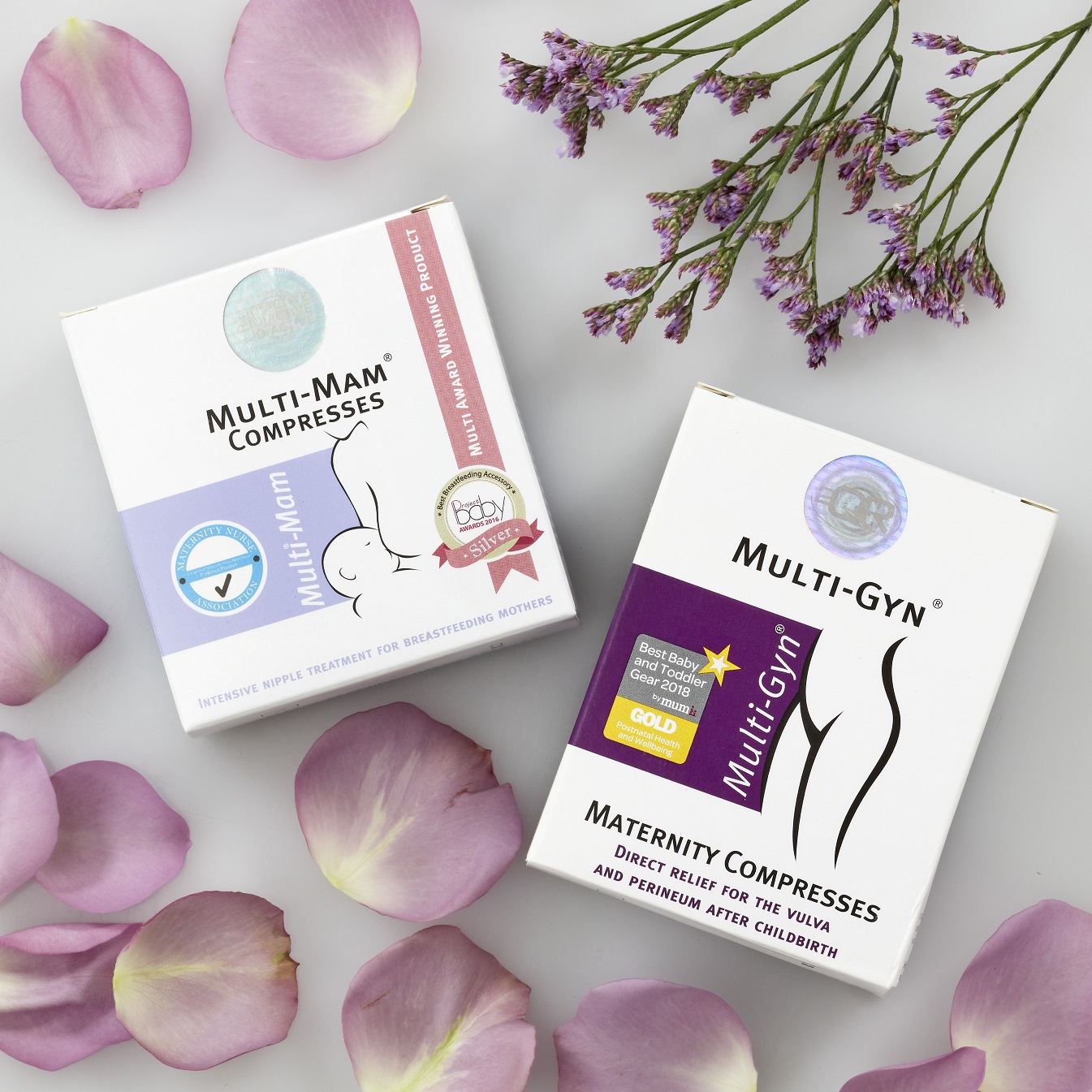
As part of World Breastfeeding Week, we spoke to Kitty for some top advice on the subject!
This week is World Breastfeeding Week and so to mark the occasion we spoke to lactation consultant Kitty Hackel, ambassador for Multi-Mam Breastfeeding Compresses, to seek some expert advice on a whole host of breastfeeding-related topics!
If a woman chooses to breastfeed, what are the benefits to both mum and baby?
Breastmilk contains all the nutrients your newborn needs and even adapts over time to the changing needs of your growing baby.
The benefits of breastfeeding for baby are significant and cannot be replicated by formula. Aside from nutrients, your breastmilk comes loaded with antioxidants, enzymes and live antibodies ready to protect your baby against illness. By nursing exclusively, you give your infant the best chance to thrive and survive, but any amount of breastmilk will be a boost to your baby’s health.
The benefits of breastfeeding for baby include:
- Protection against infections
- Protection against stomach problems like diarrhoea, constipation and vomiting
- Protection against colds and respiratory diseases like whooping cough, RSV and pneumonia
- Decreased risk of ear infections
- Decreased risk of Sudden Infant Death Syndrome
- Decreased risk of illness and premature death overall
- Decreased risk of cavities
- Leads to better brain development
- Provides bonding time for mother and baby
Many of the advantages of breastfeeding carry on into childhood and even adulthood. For example, breastfed babies are less likely to suffer from asthma, eczema and allergies when they become older. They also have a lower risk of diabetes and obesity and have stronger immune systems overall.
Your baby isn’t the only one reaping the benefits of breastfeeding. There are plenty of benefits of breastfeeding for mum as well, both immediately after birth and long-term.
The benefits of breastfeeding for mum include:
- Helps the uterus to contract after birth
- Reduces menstrual bleedings
- Provides birth control (although it’s not 100 percent effective)
- Helps with weight loss
- Lower risk of getting breast and ovarian cancer
- Fewer sick days
Breastfeeding is also better for the environment, since it doesn’t require any energy to produce and generates no waste or pollution.
Until what age would you typically recommend breastfeeding up until?
Some of the health benefits of breastfeeding even last a lifetime! Since there are so many benefits of breastfeeding, the World Health Organization recommends that mothers nurse their babies exclusively for the first six months.
What are your top tips for women who are wanting to breastfeed?
Before the baby arrives, check out your local breastfeeding group. Borrow a good breastfeeding book from your local library, invite your partner to your breastfeeding preparation class and ask your mother or mother-in-law about their feeding experiences and open the conversation.
To help get your breastfeeding off to the best start, I recommend the following:
Skin to skin contact with your baby: As long as there are no complications, the focus after birth is for you and baby to enjoy some bonding time. Skin-to-skin with your baby can help regulate their temperature, heart rate and get breastfeeding off to the best start. Skin-to-skin will trigger your body to produce Oxytocin, which will promote bonding between you and your baby and stimulate your milk production. This skin-to-skin time is the perfect setting to initiate your baby’s first feed. If you can’t have the golden hour straight away don’t worry, make it clear in your birth preferences that you wish to have this as soon as you can, bonding time is beneficial at any time, it is also lovely for Dad to have skin-to-skin and to help with bonding where possible too.
Watch your baby not the clock: Keep your baby with you as much as possible after birth so you can get to know them and their cues. Newborn babies will typically feed no less than 8 and sometimes more than 12 times each 24 hours for the first several weeks. This may look like feeding every hour, or feeding every 3 hours. Observe your baby for their hunger cues; sticking their tongue out, moving their head from side to side, rooting, opening and closing their mouth and bringing their hands to their mouth, these are all signs that your baby is hungry. Offer them the breast at this stage, it is a lot harder to latch on an upset baby, so try and feed them before they get to this point.
Limit the use of dummies: Why are we as lactation consultants not big fans? Well, as a general rule, lactation consultants don’t like the use of soothers in the early days as they mean your body is losing precious chances of frequent breast stimulation. Put simply, milk supply works on a ‘supply and demand’ basis. Our bodies respond to baby’s stimulation and when you give a soother or dummy, your breasts and brain are losing the chance to tell the body to make more milk. You can’t put off frequent feeds and expect to make enough milk. Bring baby to breast at every cue, limit pacifiers and bottles in the early days and weeks. I recommend using this technique for somewhere between 5 and 6 weeks – trust your baby and trust the process.
Do not cover your baby’s hands: When it comes to breastfeeding, babies use their hands as little radars to help them locate and latch onto the breast. Try not to get frustrated and discouraged when baby tries to get his/her hands involved at feeding time. Instead encourage them “what a clever little boy/girl you are”. Another wonderful and little-known fact about babies hands and feeding, is that immediately after delivery, you leave the amniotic fluid on baby’s hands. The smell of the lubricating fluid secreted by the Montgomery Glands on the areola smells like the amniotic fluid baby has on their hands and this helps to guide them to the breast for their first feed!
Avoid supplemental feedings: All your baby needs is you! It is very rare that I see a baby requiring more than just breast in the first 24 hours. Your milk supply works on a supply and demand basis. If you fall into the ‘top up’ trap, your body will miss an opportunity to feed and in so doing, will lower its supply to meet its new reduced demand for the following days.
Positioning and attachment: There is a reason that we call it breastfeeding and not nipple feeding. Babies should take in a mouthful of breast tissue. This will ensure less pain/nipple damage, better milk transfer and milk drainage, therefore better milk production.
Here are some of my favourite tips for latching your baby on:
- Place baby facing tummy to your tummy
- Your baby should be with their nose at the level of your nipple (using pillows and altering position can help with this)
- Tickle your baby’s nose and top lip with your nipple to trigger the reflex to open wide, like baby’s taking a big bite of a burger!
- As soon as the baby opens wide, swiftly bring baby to your breast. Not the other way round or you will end up with a very sore back/neck
- Your baby should have their chin and cheeks touching the breast
- You want to hear your baby swallowing lots. About 1 swallow for every 2-3 sucks
This might take several tries to get that deep latch and that’s okay! Don’t settle for the first one if it doesn’t feel right. You and baby are both learning together.
Know what’s normal
While breastfeeding should not be painful, your nipples may feel tender during the first 2 weeks. This is very normal. Just as your body might be achy and sore when you first take up a new sport. Here are a few things you can do to ease this discomfort:
- Follow my previous tips to ensure your baby is latching on deeply at the breast. You want your nipple to be at the point of baby’s soft palate not chomping down on your nipple with the hard palate of their mouth.
- Ensure you practice good hygiene. By simply washing your breasts with warm water and soap you may avoid minor infection very easily, and as a result reduce your risk of developing mastitis.
- Our skin repairs best in a moist wound healing environment. Allowing your nipples to “dry out” can actually cause a lot more damage than good. Multi-Mam Breastfeeding Compresses are lovely for this, as well as providing immediate relief, their combination of ingredients have been proven to support the natural flora of the nipple. I loved keeping mine in the fridge for that extra soothing, cooling effect.
If you’re exclusively breastfeeding and your baby doesn’t seem to be thriving as they should, don’t hesitate to contact a breastfeeding expert from your local hospital or La Leche League. They will be able to support you and help you to keep breastfeeding as long as you wish.
If things don’t seem to be going well, or feeding is painful seek out help. A lactation consultant can watch you feeding and give you tips and tricks to help improve your baby’s latch and encourage deeper attachment at the breast, encouraging more efficient milk transfer and a more comfortable mum.
Why is a good support system important during breastfeeding?
A new survey released to tie in with World Breastfeeding Week (1-7 August 2021), has sadly revealed that 7% British women would feel uncomfortable discussing their breastfeeding struggles with their partner. The survey, conducted by Multi-Mam Breastfeeding Compresses, found the same number of women said they would also feel uncomfortable discussing these issues with their GP and 11% said they would even feel uncomfortable talking about their struggles with their mum.1
Research has found that there is a strong link between breastfeeding success and a good support system, so it’s vital that women feel able to come forward and admit their difficulties and concerns and if necessary, seek additional help. A hospital-based study 24 hours postpartum showed how “Strong approval of breastfeeding by the partner was associated with a high incidence of breastfeeding (98.1%), compared to only 26.9% breastfeeding when the partner was indifferent to feeding choice.”2
However, this can apply to a woman’s entire support system – sister, cousin, friend, fellow mama, partner or mother-in-law – all in all, support matters!
Are there any brilliant products/brands that you would highly recommend for breastfeeding mums?
Discomforts such as sore nipples, tiredness and teething are common among mothers with a newborn. To help you through the first period of motherhood Multi-Mam offer a range of products for sore nipples, nipple care, breastfeeding and teething.

The 2QR-complex ingredient used in Multi-Mam Breastfeeding Compresses supports the natural healing process and restores the microbial balance of the nipple. The compresses are available at Boots, online at Amazon and at independent pharmacies.
Breastfeeding in public is not for all women – but babies are hungry little beings. What advice would you give to mums who prefer to feed with a bit of privacy, whilst out and about?
A beautiful breastfeeding scarf can be a simple and discreet option to feed your baby while out and about.

